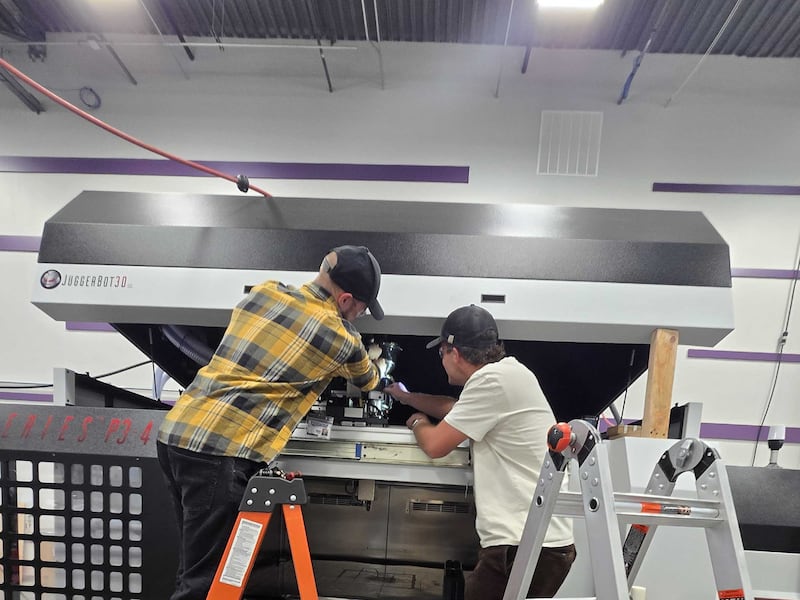Engineering students at Weber State University and other universities across the state are pushing the boundaries of what students can achieve in real-world learning environments.
“I’m actually seeing what I’m learning being applied into the actual field,” said Ethan Earnshaw, a mechanical engineering student at Weber State University’s Miller Advanced Research and Solutions (MARS) center.
Since beginning his internship at the MARS center last May, Earnshaw has developed many interests through his hands-on experience in composite manufacturing — a process that enables the facility to design and manufacture strong, lightweight parts for aerospace and defense.
Weber State has a unique opportunity to be one of the only institutions to implement such a program, using partnerships with leaders in the aerospace industry in northern Utah, such as Hill Air Force Base and Northrop Grumman.
“For a company to invest in new technology like this, it’s too expensive, not just from the fact you have to buy the equipment and develop processes, but then you have to qualify and replace what’s currently in place,” said MARS Executive Director Benjamin Garcia. “By taking that capability now, the MARS Center is allowing companies to make that transition a lot faster.”
One example of the parts produced at the MARS Center is an ongoing collaboration with the Biomedical Advanced Research and Development Authority. It specializes in pharmaceutical manufacturing in space, and the MARS center can 3D-print the heat shields necessary for reentry into Earth’s atmosphere.
Earnshaw is currently testing the strength of the carbon fiber used in the 3D-printed parts.
“We’re just seeing how different carbon fibers handle in different scenarios, like a room temperature test. We’re going to put it in a furnace and raise the temperature to see how it compares from normal room temperature to high extreme temperatures,” he said.
In addition to student-led projects, a unique feature of the MARS facility is its vertical integration and the capabilities it delivers. A student working at the center can see a product from start to finish.
For one senior project, this means directly addressing sustainability: Three engineering students are now working to challenge established industry norms by utilizing recycled plastic materials for large-scale 3D printing.
“We partnered with a plastic recycler in Salt Lake that is supplying us with a material that’s known as regrind,” said Koby Pack, a manufacturing engineering senior who is currently working on the project along with product design and development student Trisden Reeder and Nate Costa, who is focusing on process engineering.
Achieving the right consistency and strength with regrind plastics is an ongoing experiment. “Virgin material is way more consistent, but it’s exciting to push the boundaries of what’s possible with recycled content,” Pack said.
According to Costa, the recycled plastic pellets, which come in various sizes and colors, have an unknown origin. “Some of them we do know, the black stuff is recycled hot tubs, and the green pellets are recycled garbage cans,” he said.
“Recycled plastic is almost like a mystery meat of material,” Pack added. “That’s what we’re battling through right now. Can we figure it out? And can we make something that’s usable?”
The yearlong project began as a collaboration effort between the trio, prototyping different ideas before settling on a design that could be manufactured and mass-produced.
“It’s a 3D modular interlocking planter box. So you would put soil in there. No fasteners are required. It could be assembled by anyone and everyone,” Reeder said. “Someone could build a 10-foot-long planter box, or a 4-foot-long one — the same system adapts to what you need.”
By utilizing the Juggerbot 3D, a large-format additive manufacturing 3D printer, the trio of seniors is eager to test their creation in real-life situations.
For many of the students, the internship is more than just a “resume booster.” It provides the students with endless opportunities to use their imagination to push the possibilities of what engineering can achieve in an academic setting and apply it to real-world situations.
“The thing I love most about the MARS center, personally, is how hands-on everything is,” said Tylin Waters, an electrical engineering intern who switched to manufacturing engineering partly due to his work at the center.
“I’ve had internships before that is sitting on a computer screen, just coding, writing files. It’s just not the most exciting. But here we actually get to make the stuff,” Waters said. “Students really get to take more ownership of their projects than you might in other internships. The full-time engineers who are there to kind of guide us along, and once we have an idea of what we are doing, they kind of let us go.”
Derek King, who leads technical research, scientist Devin Young and Garcia supervise the center’s numerous projects. Under their supervision, most of the work at MARS is completed by college engineering students. Though paid student internships are not exclusive to Weber State students, Garcia says University of Utah, Southern Utah University and Utah State University students have completed internships at the facility.
Ultimately, the projects undertaken at the MARS Center are more than just academic exercises.
“Most of the work we’re doing here is externally funded projects that we get our students to work on; they get paid out of those contracts,” Garcia said. This model ensures that students, whether they come from Weber State, the University of Utah, Southern Utah University or Utah State University, are gaining professional, industry-relevant experience that is funded directly by the needs of the aerospace and defense community, demonstrating a unique pathway for translating classroom knowledge into real-world engineering solutions.

